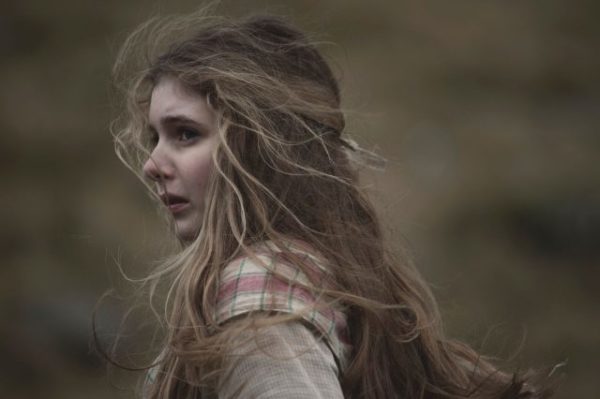WATCH CLOSELY: “Gwen” is Moody, Moving Folk Horror
By Peg Aloi
William McGregor has crafted a remarkable debut feature, a notable addition to the burgeoning crop of indie folk horror offerings.
Gwen, directed and written by William McGregor. Streaming on Amazon Prime.

Eleanor Worthington-Cox in “Gwen.”
Set during the First World War, Gwen is a sort of folk horror chamber piece filmed amid the sweeping valleys and majestic hills of north Wales. Writer-director William McGregor, whose TV credits include Misfits and Poldark, has crafted a remarkable debut feature, a notable addition to the burgeoning crop of indie offerings. Folk horror is hot now — social media groups, blogs, books, and original artwork abound — inspired by a sub-genre whose roots lie in three seminal British horror films: The Witchfinder General (1968), The Blood on Satan’s Claw (1971), and The Wicker Man (1973). Themes in these films include paganism, human sacrifice, spooky landscapes, and strange folklore practices. More recent iterations include The Witch, The Ritual, The Wind, and of course Midsommar, among many others.
The film opens with atmospheric shots of the misty moors surrounding a rural farm. The heart stopping landscape of Caernarvon in northern Wales is a character in its own right here. And, as we’ve seen in other folk horror offerings, the animistic qualities of the land breed superstitious beliefs — not to mention magic and mysticism. Gwen (Eleanor Worthington-Cox in a smashing break out role) is the teenage daughter of Elen (Maxine Peake, seen in the “Metalheads” episode of Black Mirror), who runs a farm on the edge of a village where quarrying and mining have become the main industry. In the first scene, Elen and daughters Gwen and Mari pass by a home where, they’re informed, the inhabitants have died of cholera. They see a mangled sheep carcass and keep walking. We soon learn the man of their household, seen in lighthearted loving flashbacks, has gone off to war and his wife and two young daughters are struggling to keep the farm afloat.The newly-deceased neighbor family seems a sort of omen.
Gwen goes about her chores with a mix of industriousness and dreamy pauses for introspection. Gwen is affectionate and playful with her younger sister Mari (Jodie Innes), but works hard to help her mother tend the sheep and hens and harvest vegetables for the market. The three attend church on Sundays and mostly keep to themselves. A harsh-looking man with grim-faced henchmen visits the farm and is told in no uncertain terms by Elen to get off her property. They want her to sell the land for quarrying, but she has no intention of letting the farm go, saying she must keep things in order for when her husband returns. Returning from the village one day, they find a sheep’s heart, pierced by iron nails, hanging on their front door. Elen burns it in the fire, and says nothing. An eerie quality of menace and terror seeps out of the misty meadows. But the real threat is the ruthless, greedy quarry owners.
Still, a faint whiff of witchcraft wafts through the air: we know what happens to women alone in the countryside, without men to protect them, or neighbors to vouch for them. There is no supernatural subplot here; the witch craze is ancient history. But dark things begin to happen, almost as if the farm has been hexed. A boy who likes Gwen is chastised for smiling at her in church. Things go from borderline to bad when Elen, exhausted, begins to have seizures (also once interpreted as a sign of witchcraft). Gwen sees the local doctor (Kobna Holdbrook-Smith), who is oddly in league with the village land grabbers. Still, he has compassion for Gwen’s situation and gives her some medicine for her mother, with Gwen promising to pay him after the next market day. Then things go from bad to worse when all the sheep are found slaughtered. Gwen recalls the family struck by cholera, wondering if her own family is being sabotaged. She digs up potatoes in the field that seem to have already rotted. Shrill birds caw in the distance.
The story is steeped in the ominous trappings one would expect in a tale of witch hysteria, but Gwen focuses on the perverse brutality of men who set upon women thought to be weak or defenseless. The prominence of the landscape and the issue of ownership suggests the domination of consumption (and, of course, colonization, as in another recent folk horror film, The Nightingale). Natural resources are to be drained rather than nurtured. What has exploitation of the earth to do with the exploitation of women? Everything, as it turns out. Gwen becomes a story of resistance as much as it is one of victimization. A more romantic perspective would rejoice that perseverance and integrity is rewarded. The darkness that befalls the beautiful, kind protagonist, who only tries to help her family, is as familiar as a fairy tale. But its horror is grimly real.
The production elements feel elemental and humble, despite the grandeur of the setting, yet their authenticity is beguilingly perfect, from the muddy streets and candlelit cottages to the rough linen clothing. The performances are superb, particularly Peake and Worthington-Cox, locked into a feminine struggle of protection and sacrifice. I found myself thinking that some of the year’s most powerful films so far have explored the depth of women’s power and anger with daring artfulness. Gwen is a thoughtful thriller that seeps in, reminding viewers that the more complex our lives become, the more our simplest desires and dilemmas are laid bare.
Peg Aloi is a former film critic for The Boston Phoenix. She taught film studies in Boston for over a decade. She writes regularly for The Orlando Weekly, Crooked Marquee, and Bloody Disgusting. Her blog “The Witching Hour” can be found at at themediawitch.com.
